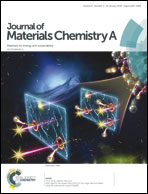Cellulose nanofibril/boron nitride nanosheet composites with enhanced energy density and thermal stability by interfibrillar cross-linking through Ca2+†
Abstract
Flexible and eco-friendly dielectric materials with high energy density and breakdown strength have promising applications in energy storage devices. Here, cellulose nanofibril/boron nitride nanosheet nanocomposite films were fabricated from 2,2,6,6-tetramethylpiperidine-1-oxyl radical (TEMPO)-oxidized cellulose nanofibrils (TOCNs) and hexagonal boron nitride nanosheets (BNNSs) in aqueous dispersions. The obtained TOCN/BNNS nanocomposites were further cross-linked by immersion in aqueous CaCl2 solution to improve their properties. The maximum discharged energy density of the finally prepared composite film was 3.9 J cm−3 with only 4 vol% of BNNSs at 380 MV m−1, achieving greater enhancement than the neat TOCN film with a low energy density of 0.1 J cm−3 at 50 MV m−1. It is much higher than the previously reported highest energy density of biopolymer-based composites (0.81 J cm−3) and also higher than that of the commercially available best dielectric polymer BOPP (2 J cm−3). Moreover, the nanocomposite films exhibited excellent mechanical flexibility and significantly improved thermal stability (100 °C increase in thermal decomposition temperature).



 Please wait while we load your content...
Please wait while we load your content...